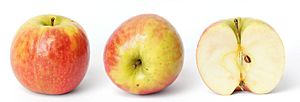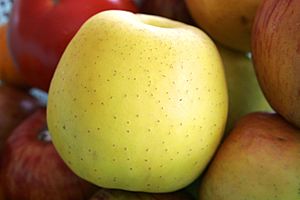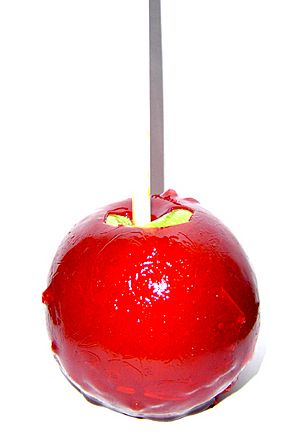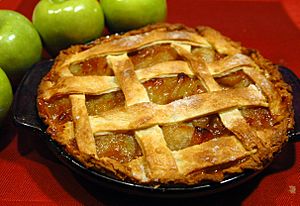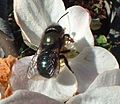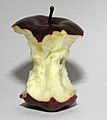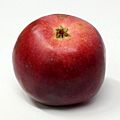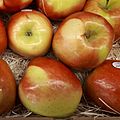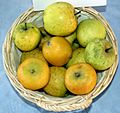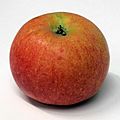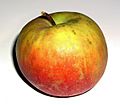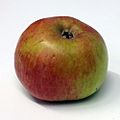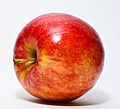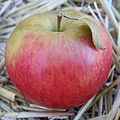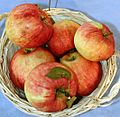Apple facts for kids
The apple tree (scientific name: Malus domestica) is a tree that loses its leaves every year. It belongs to the rose family. Apple trees are famous for their sweet, round fruit, the apple. People grow apple trees all over the world. They are the most common type of tree in the Malus group.
Apple trees first grew in Central Asia. Their wild ancestor, Malus sieversii, still grows there today. People have been growing apples for thousands of years in Asia and Europe. European settlers brought apples to North America. Apples are important in many old stories and beliefs, like those from Norse, Greek, and Christian traditions.
Apple trees can grow very big if they start from a seed. But they stay smaller if a part of them is joined onto another plant's roots (this is called grafting). There are over 7,500 different kinds of apples, called cultivars. Each kind has its own special taste and use. Some are best for cooking, some for eating fresh, and others for making cider.
In 2013, the world produced 80.8 million tonnes of apples. China grew almost half of all these apples.
Contents
What is an Apple Tree?
Apple trees are small trees that lose their leaves. They usually grow between 3 and 12 meters (10 to 40 feet) tall. They have a wide, rounded top with thick branches.
Apple Leaves and Flowers
The leaves of an apple tree grow one after another along the branch. They are simple oval shapes, about 5 to 12 centimeters (2 to 5 inches) long. The leaves have a pointed tip and a soft underside.
Apple trees get their flowers in the spring. This happens when the leaves start to grow. The flowers are white, sometimes with a little pink color. Each flower has five petals and is about 2.5 to 3.5 centimeters (1 to 1.4 inches) wide.
How Apples Grow
The apple fruit becomes ripe in the autumn. It is usually 5 to 9 centimeters (2 to 3.5 inches) wide. Inside the apple, there are five small sections shaped like a star. Each section holds one to three seeds.
Wild Apples
The wild ancestor of today's apple trees is called Malus sieversii. These wild apples grow in the mountains of Central Asia. You can find them in places like Kazakhstan, Kyrgyzstan, Tajikistan, and Xinjiang, China.
Unlike the apples we eat, the leaves of wild apple trees turn red in autumn. Scientists are now using these wild apples. They help to create new types of Malus domestica that can grow in colder places.
History of Apples
The apple tree might be one of the very first trees people ever grew on purpose. Over thousands of years, the fruits have become much better. It is believed that Alexander the Great found small apple trees in Asia Minor around 300 BC.
For thousands of years, people in Asia and Europe used apples as an important food, especially in winter. When Europeans came to North America, they brought apples with them. The first apple orchard in North America was supposedly planted near Boston in 1625. In the 1900s, growing apples became a big business.
Different Kinds of Apples
If you want to grow a specific type of apple, you can't just plant a seed from that apple. An apple seed gets its DNA from two different apple trees. This means the tree that grows from the seed will be a mix of both. It won't be exactly like the apple you got the seed from.
To grow a certain type of apple, people use a method called grafting. They cut a small branch, called a 'scion', from the apple tree they like. Then, they attach this scion onto a special root system called a rootstock. The new tree that grows will only produce apples of the desired type.
There are more than 7,500 known types of apples, called cultivars. Some are grown for eating fresh, which are called dessert apples. Others are grown just for cooking or for making cider. Cider apples are often too sour to eat raw. However, they give cider a rich flavor that dessert apples cannot.
Most popular apples today are soft but also crisp. They also have colorful skin, are easy to ship, and can resist diseases. Modern apples are usually sweeter than older types. This is because people's tastes have changed. Most people in North America and Europe like sweet apples. In Asia and India, very sweet apples with almost no sour taste are popular.
Apples in the United Kingdom
In the United Kingdom, there are about 3,000 different types of apples. The most common cooking apple grown in England is the 'Bramley seedling'.
Apple orchards are not as common as they were in the early 1900s. Back then, apples were rarely brought in from other countries. 'Apple Day' is celebrated every October 21 in many countries.
Apples in North America
Many apples are grown in the temperate parts of the United States and Canada. In places where apple growing is important, people have big celebrations:
- The Annapolis Valley Apple Blossom Festival is held for five days every spring (May-June) in Nova Scotia.
- The Shenandoah Apple Blossom Festival takes place for six days every spring in Winchester, Virginia.
- The Washington State Apple Blossom Festival is celebrated for two weeks every spring (April-May) in Wenatchee, Washington.
Popular Apple Types
There are many different types of apples. Here are some popular ones:
- Fuji
- Gala
- Golden Delicious (sometimes called a Green Delicious Apple)
- Granny Smith
- Jonagold
- McIntosh
- Pink Lady
- Red Delicious
- Winesap
- Cox's Orange Pippin
How People Use Apples
You can eat the whole apple fruit, including the skin. However, most people don't eat the core or the seeds.
Apples can be eaten in many ways. You can drink apple juice, eat them raw in salads, bake them in pies, or cook them into sauces.
People use different ways to keep apples fresh. Apples can be canned, dried, or frozen. Canned or frozen apples are often used later for baking. Apple juice or cider is also bottled. Apple juice is often made into a thick liquid and then frozen.
Common Uses of Apples
Apples are often eaten raw. The types of apples grown for eating raw are called dessert or table apples.
- In the UK, a toffee apple is a traditional sweet treat. It's an apple covered in hot toffee that cools and hardens. In the U.S., similar treats are candy apples (covered in hard sugar syrup) and caramel apples (covered with cooled caramel).
- Apples are eaten with honey during the Jewish New Year, Rosh Hashanah. This symbolizes a sweet new year.
Apples are a key ingredient in many desserts. These include apple pie, apple crumble, apple crisp, and apple cake. When cooked, some apple types easily turn into a smooth puree called apple sauce. Apples are also made into apple butter and apple jelly. They are often baked or stewed and can even be cooked in some meat dishes. Dried apples can be eaten as they are or soaked in water to make them soft again.
Apples are also used to make drinks like apple juice and cider. Cider usually has a small amount of alcohol, similar to beer. The regions of Brittany in France and Cornwall in England are famous for their apple ciders.
When sliced, apples can turn brown when exposed to air. This happens because natural substances in the apple react with oxygen. Some apple types turn brown more easily than others. Special genetically engineered apples, called Arctic Apples, do not turn brown. You can also treat sliced apples with acidulated water (water with a little acid) to stop them from browning.
Cooking with Apples
Apples are used in many cooked dishes, but they are also often eaten uncooked. The inside of the apple fruit is firm. Its taste can be anywhere from sour to sweet. Apples used for cooking are often sour and need sugar added when cooked. Sweet apples can be eaten without cooking. The seeds are in the middle of the apple. You can remove them with a special tool or carefully with a knife.
Many apples are good to eat raw. They are also used in many kinds of baked foods, like apple pie. Apples are cooked until they are soft to make apple sauce.
Apples are also made into drinks like apple juice and cider. Cider usually contains a little alcohol, about as much as beer. The regions of Brittany in France and Cornwall in England are well-known for their apple ciders.
Images for kids
-
"Brita as Iduna" (1901) by Carl Larsson
-
Apple blossom from an old Ayrshire cultivar
-
Orchard mason bee on apple bloom, British Columbia, Canada
-
L. K. Relander, the former President of Finland, with his family picking apples in the 1930s
-
'Fuji'
-
'Gala'
-
'Goldrenette', ('Reinette')
-
'Jonagold'
-
'McIntosh'
-
'Sciros'
See also
 In Spanish: Manzana para niños
In Spanish: Manzana para niños


